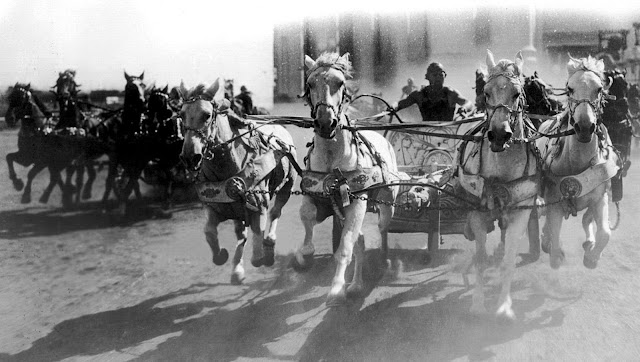Ben-Hur (1925)
Fred Niblo's "Ben-Hur"
The 1925 epic "Ben-Hur" is the most expensive silent film ever made. At a whopping $3.9 million, the film contained epic sets, thousands of extras, large action sequences, and even technicolor sequences. The technicolor sequences used in the film are some of the first color used in film history (1922's "Toll of the Sea" was the first technicolor film).
The plot of the film centers around a young Jewish prince named Ben-Hur at the time of Jesus' life. After a false accusation, Ben-Hur is arrested by a corrupt Roman named Messala and enslaved by the Roman army. After spending years as a slave on a Roman galley, he saves the life of an elder Roman officer. The officer then grants him freedom. With his freedom, he becomes a famous chariot racer. He eventually faces off with Massala and defeats him. After the race, he is reunited with his mother and sister, whose leprosy has been cured by Jesus Christ.
The film is based on an 1880 novel by General Lew Wallace. Production for the film began in Italy in 1923 under Goldwyn. Director changes, recastings, and expensive reshoots caused the budget for the film to skyrocket. By the time Goldwyn had merged to become Metro-Goldwyn-Mayer (MGM), the production costs were enormous.
Perhaps the most famous scene in the film is the chariot race sequence. Cameras were placed on the ground so the riders could ride over them (in the style of John Ford's "The Iron Horse). Cameras were also placed in separate cars which ran parallel to the riders. The sequence is often credited as being the "most edited sequence in film history." Due to the rapid editing (in the vain of Sergei Eisenstein's Soviet films), the exhilaration of the scene is palpable. The rapid editing between riders, audience reactions, and the various angles create an intense excitement due to the pace with which a viewer's attention must keep up. The scene was recreated shot-for-shot in the 1959 remake of the film and even heavily influenced George Lucas's pod-racing sequence in the 1999 film "The Phantom Menace."
Despite being wildly successful and making well over $9 million worldwide (MGM's highest-grossing film at the time), the film did not overcome its bloated budget and advertising. It ended up being under profit until 1931 when it was re-released. Despite its negative profit earnings, the film was immensely popular and a critical darling. Many were excited by the epic scope and intense action sequences. Many were in awe of the portrayal of the rise of Christianity and the color sequences depicting Mary and eventually Jesus. No one had ever seen a film with such a spectacle before. In 1997, the film was added to the Library of Congress.




Comments
Post a Comment